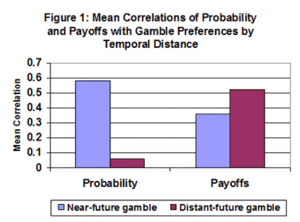A charity website, www.longbets.org, holds high stakes bets for individuals interested in wagering on social and scientific issues. Participants give financial winnings to a charity of their choice and retain the prestige of accurately predicting, for example, whether by 2020, bioterror or bioerror will lead to one million casualties in a single event. More lighthearted bets suggest that the USA men’s soccer team will win the World Cup before the Boston Red Sox will win the World Series.1 Participants can wager a minimum of $1,000, but the website reports individual stakes of up to $10,000. One stated goal of “Longbets” is to encourage global thinking, rather than local thinking by hosting unusually long bets.
But, can time influence cognition? Sagristano, Trope, & Liberman (2002) examined this issue in a series of research studies. They hypothesized that individuals perceive similar bets as more or less desirable depending on the amount of time before a wager is placed. In one study Sagristano et al. (2002) tested the gambling preferences of 63 (41 female) university students.2 The authors asked study participants to rate 20 randomly ordered gambles varying in probability of winning and expected value3 and informed participants that they would have the opportunity to play either in the near-future (immediately) or in the distant-future (2-month delay). Bets could fall into one of five win probability groups (0.1, 0.3, 0.5, 0.7, and 0.9) that varied -2 to 2 from the exact probability.4 One of four expected values ($4, $6, $8, and $10) could also categorize bets. For any given expected value, probability of winning and payoff are inversely related; Table 1 displays the probability/payoff tradeoffs for an expected value of $10.
Table 1: Expected Value and Probability/Payoff Tradeoffs
For each participant the authors used regression to measure the degree to which both probability and payoffs related to participants’ gamble preferences. The authors then statistically compared the resultant regression coefficients of individuals assigned to near-and distant-future gambles. Figure 1 shows that coefficients declined as time increased (t(58)=-7.05 p<0.001) and the relatedness of payoffs and preferences increased as time increased (t (58)=2.86 p<0.01).
The results indicate that the probability of winning had less influence on preferences as temporal distance increased. In contrast, payoffs had more influence on preferences as temporal distance increased. In other words, in near future gambles, individuals focused more on the feasibility of winning when ordering their preferences; in distant-future gambles, individuals focused more on the size of the prize when ordering their preferences. For example, Table 2 shows that for all bets with an expected value of $10, individuals in the near-future condition rated the 0.1 bet (i.e. 10 in 100 chances of winning $100) as the least favored bet and the 0.9 bet (i.e. 90 in 100 chances of winning $11) as the most preferred. In contrast, of all bets with an expected value of $10, individuals in the distant-future condition rated the 0.9 bet as the least favorable bet and the 0.1 bet as the most favorable. These findings reveal that a wager is not always the same wager.
Table 2: Bet Preferences for $10 Expected Value Bets by Temporal Distance
Sagristano et al. suggest a shift in focus from the feasibility of winning to the desirability (value) of the prize best explains their results. This is consistent with Construal Level Theory (Liberman & Trope, 1998), which suggests that people process events in the near-future contextually (or concretely) and events in the distant-future schematically (or abstractly). Alternative explanations might consider behavior economics and the utility of payoff. This research is important not only because it demonstrates the malleability of individuals’ cognitive processes, but also because it continues recent scientific efforts (see WAGER 7(36)) to bridge theoretical and applied research. Researchers need to determine whether these results generalize to nonstudent populations and to conduct more research to determine whether established preferences hold over time. How will the participants of a 50 year “Longbet” feel as the 50th year approaches?
Comments on this article can be addressed to Debi LaPlante.
Notes
1. This bet is potentially the longest of all, including whether or not extraterrestrials will be discovered someplace other than a planet or satellite of a planet.
2. Sagristano et al. (2002) actually report 2 preliminary and 4 experimental studies. Due to space limitations, the WAGER only reports a portion of Experiment 1; however, all of the experiments supported the authors’ predictions about time.
3. Expected Value = Probability of Winning x Payoff.
4. A probability value of 0.01 is equivalent to 1 chance in 100. The odds in this probability group could range from 8 chances to 12 chances in 100.
References
Liberman, N., & Trope, Y. (1998). The role of feasibility and desirability considerations in near and distant future decisions: A test of temporal construal theory. Journal of Personality and Social Psychology, 75, 5-18.
Sagristano, M. D., Trope, Y., & Liberman, N. (2002). Time-dependent gambling: Odds now, money later. Journal of Experimental Psychology: General, 131, 364-376.






